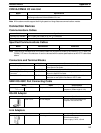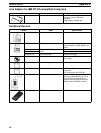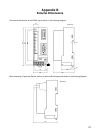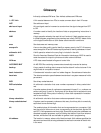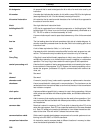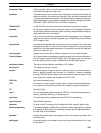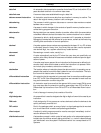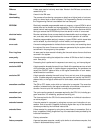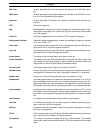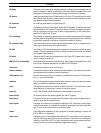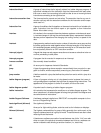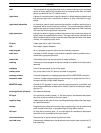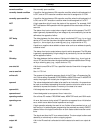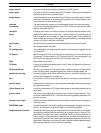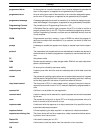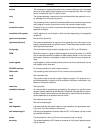
Glossary
104
FAL error An error generated from the user program by execution of an FAL(06) instruc-
tion.
FALS error An error generated from the user program by execution of an FALS(07) instruc-
tion or an error generated by the system.
fatal error An error that stops PC operation and requires correction before operation can
continue.
FCS See frame checksum.
flag A dedicated bit in memory that is set by the system to indicate some type of oper-
ating status. Some flags, such as the carry flag, can also be set by the operator
or via the program.
flicker bit A bit that is programmed to turn ON and OFF at a specific frequency.
floating-point decimal A decimal number expressed as a number (the mantissa) multiplied by a power
of 10, e.g., 0.538 x 10
–5
.
force reset The process of forcibly turning OFF a bit via a programming device. Bits are usu-
ally turned OFF as a result of program execution.
force set The process of forcibly turning ON a bit via a programming device. Bits are usu-
ally turned ON as a result of program execution.
forced status The status of bits that have been force reset or force set.
frame checksum The results of exclusive ORing all data within a specified calculation range. The
frame checksum can be calculated on both the sending and receiving end of a
data transfer to confirm that data was transmitted correctly.
function code A two-digit number used to input an instruction into the PC.
hardware error An error originating in the hardware structure (electronic components) of the PC,
as opposed to a software error, which originates in software (i.e., programs).
header code A code in an instruction that specifies what the instruction is to do.
hexadecimal A number system where all numbers are expressed to the base 16. In a PC all
data is ultimately stored in binary form, however, displays and inputs on Pro-
gramming Devices are often expressed in hexadecimal to simplify operation.
Each group of four binary bits is numerically equivalent to one hexadecimal digit.
host computer A computer that is used to transfer data to or receive data from a PC in a Host
Link system. The host computer is used for data management and overall sys-
tem control. Host computers are generally small personal or business comput-
ers.
host interface An interface that allows communications with a host computer.
host link An interface connecting a PC to a host computer to enable monitoring or pro-
gram control from the host computer.
HR area A memory area that preserves bit status during power interrupts and used as
work bits in programming.
I/O bit A bit in memory used to hold I/O status. Input bits reflect the status of input termi-
nals; output bits hold the status for output terminals.
I/O capacity The number of inputs and outputs that a PC is able to handle. This number
ranges from around one hundred for smaller PCs to two thousand for the largest
ones.



